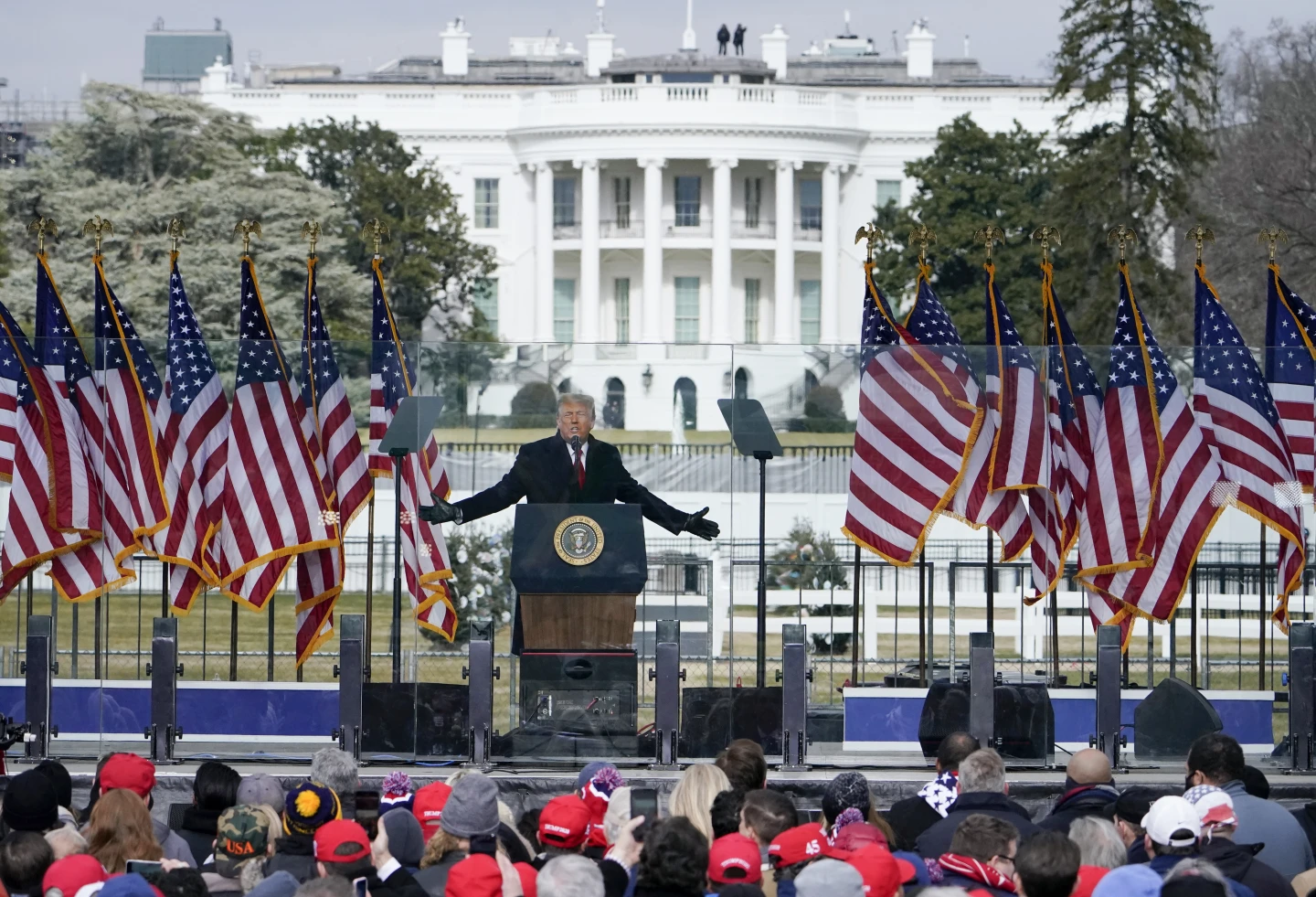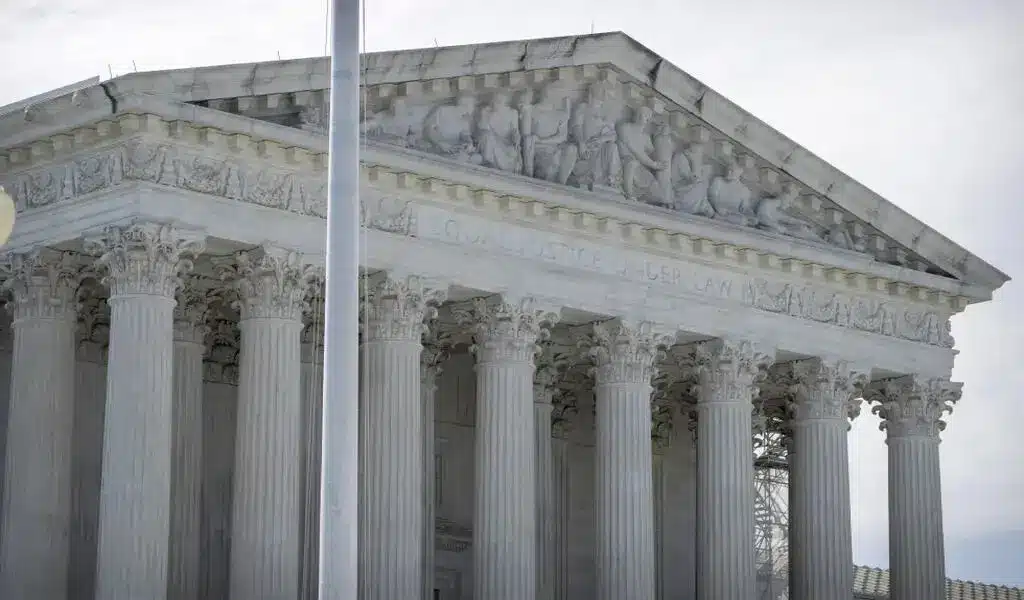News
U.S. Judge To Determine Start Date For Trump’s Trial On Charges Of Election Interference

(CTN NEWS) – On Monday, a federal judge is anticipated to establish the commencement date for the criminal trial of former United States President Donald Trump. He faces charges of attempting to invalidate his 2020 election loss in an unsuccessful effort to retain his presidency.
Special Counsel Jack Smith initiated the criminal proceedings in Washington, D.C. This particular case is one among four that Trump, who is currently leading the race for the 2024 Republican presidential nomination, is confronted with.
Among all the cases, this one comprehensively examines his endeavor to overturn the election results and undo his defeat against Democrat Joe Biden.
Expected to face state criminal charges in Georgia for attempting to reverse his electoral loss, former President Donald Trump made an appearance at a Georgia jail on Thursday. However, it is unlikely that he will attend the upcoming Monday hearing.
Trump has previously criticized U.S. District Judge Tanya Chutkan, accusing her of bias against him without providing any substantiating evidence.
He has consistently portrayed all four of his ongoing criminal cases as politically motivated strategies aimed at obstructing his potential return to power.
READ MORE: Trump’s Campaign Garners $20 Million Amid Legal Challenges And Indictment Controversy

Trial Start Date Proposed by Special Counsel Smith’s Office and Clash Over Timing
The office of Special Counsel Jack Smith has put forth a proposal to commence the trial on January 2, 2024, approximately 11 months ahead of Election Day.
They estimate the proceedings to last four to six weeks. Conversely, Trump’s legal team has urged Judge Chutkan to postpone the trial until April 2026, arguing that the paramount concern is ensuring a fair and just trial rather than a rushed judgment.
Trump’s attorneys have expressed concerns over the immense volume of evidence provided by the government, totaling 11.5 million pages.
They likened the stack of pages to dwarfing the Washington Monument and compared the task of reviewing these documents to reading Leo Tolstoy’s ‘War and Peace’ 78 times daily, a task they consider impractical and overwhelming.
Prosecutors from Special Counsel Smith’s office, however, have deemed these comparisons unhelpful and lacking insight.
They contend that a substantial portion of the evidence comprises records accessible to Trump himself, including his tweets and campaign statements, along with publicly available documents from the Democratically-led U.S. House select committee’s investigation into the Capitol attack on January 6.
A significant logistical challenge Trump and his legal team confront is coordinating court appearances across four upcoming criminal trials while he actively campaigns for a White House comeback.
READ MORE: Former President Trump Surrenders And Receives Mug Shot Amidst Allegations Of Election Subversion

Trump’s Multiple Trials Across States: Dates, Charges, and Legal Proceedings
In Georgia, Trump faces charges related to racketeering and his alleged endeavors to overturn the 2020 election results. District Attorney Fani Willis has requested a trial date of March 4, 2024.
Another defendant, attorney Kenneth Chesebro, will face trial on October 23 as per a judge’s decision, while a trial date for other defendants, including Sidney Powell, an attorney who propagated false election fraud claims, is yet to be set.
Trump’s trials also extend to New York, scheduled for March 25, 2024, where he faces state charges for concealing hush money payments. Manhattan District Attorney Alvin Bragg has indicated a willingness to collaborate with other authorities to resolve scheduling conflicts.
Furthermore, Trump is slated for trial in Florida on May 20, 2024, facing federal charges by Special Counsel Smith for retaining classified records post his White House tenure and attempting to obstruct justice.
While Trump has pleaded not guilty to charges across New York, Florida, and Washington, his arraignment in Georgia is impending, with an expected plea of not guilty.
This upcoming Monday will mark the second instance of Trump’s legal team appearing before Judge Chutkan to discuss logistical matters before the trial.
During the previous hearing, Judge Chutkan cautioned Trump against making inflammatory online statements concerning witnesses and other case-involved parties.

October 23 Trial Date in Trump Election Subversion Case by Fulton County DA Sparks Debate
Earlier on Thursday, Fulton County District Attorney Fani Willis formally requested a trial date of October 23 for the case she has filed against Trump and 18 associates, accusing them of election subversion.
While the feasibility of this date remains uncertain, being the potential inaugural trial among Trump’s four criminal cases, its realization would mark a significant milestone.
During proceedings in Georgia, Trump’s legal team expressed their opposition to Willis’ suggested trial date. They also intend to pursue the separation of Trump’s case from that of co-defendant Ken Chesebro.
Chesebro’s efforts to expedite the proceedings prompted Willis to propose the mentioned trial date.
Willis’ proposed timeline seeks to expedite the legal process significantly. Last week, upon the indictment’s announcement, she indicated her intention to secure a trial commencement within a span of six months.
Legal experts previously commented that the proposed timeline seemed implausible, especially considering Willis’ intention to conduct a joint trial involving all 19 defendants.
Lawyers representing Trump and his co-defendants have hinted at the likelihood of pre-trial disputes that could protract the proceedings.
Notably, three of the defendants are actively pursuing a shift of the case to federal court, and it is anticipated that the former president will undertake a similar legal maneuver.
A separate expansive anti-racketeering case led by Willis underscores the unrealistic nature of such an expedited timeline.
This case involves allegations against Jeffrey Williams, the rapper known as Young Thug, and his associates for purportedly violating Georgia’s RICO law—a central charge also present in the Trump case.
Despite Williams’ attempt to assert his right to a swift trial, the legal process has progressed slowly.
In light of these complexities, Willis has requested that the arraignment of the 19 defendants take place next month.
RELATED CTN NEWS:
Delayed Lunar Ascent: Japan’s Inaugural Moon Mission Postponed Due To Strong Winds
WhatsApp Scam: Mumbai-based Football Coach Loses Rs 9.8 Lakh To Convincing Fake Job Offer

News
Trudeau’s Gun Grab Could Cost Taxpayers a Whopping $7 Billion

A recent report indicates that since Trudeau’s announcement of his gun buyback program four years ago, almost none of the banned firearms have been surrendered.
The federal government plans to purchase 2,063 firearm models from retailers following the enactment of Bill C-21, which amends various Acts and introduces certain consequential changes related to firearms. It was granted royal assent on December 15 of last year.
This ban immediately criminalized the actions of federally-licensed firearms owners regarding the purchase, sale, transportation, importation, exportation, or use of hundreds of thousands of rifles and shotguns that were previously legal.
The gun ban focused on what it termed ‘assault-style weapons,’ which are, in reality, traditional semi-automatic rifles and shotguns that have enjoyed popularity among hunters and sport shooters for over a century.
In May 2020, the federal government enacted an Order-in-Council that prohibited 1,500 types of “assault-style” firearms and outlined specific components of the newly banned firearms. Property owners must adhere to the law by October 2023.
Trudeau’s Buyback Hasn’t Happened
“In the announcement regarding the ban, the prime minister stated that the government would seize the prohibited firearms, assuring that their lawful owners would be ‘grandfathered’ or compensated fairly.” “That hasn’t happened,” criminologist Gary Mauser told Rebel News.
Mauser projected expenses ranging from $2.6 billion to $6.7 billion. The figure reflects the compensation costs amounting to $756 million, as outlined by the Parliamentary Budget Office (PBO).
“The projected expenses for gathering the illegal firearms are estimated to range from $1.6 billion to $7 billion.” “This range estimate increases to between $2.647 billion and $7 billion when compensation costs to owners are factored in,” Mauser stated.
Figures requested by Conservative MP Shannon Stubbs concerning firearms prohibited due to the May 1, 2020 Order In Council reveal that $72 million has been allocated to the firearm “buyback” program, yet not a single firearm has been confiscated to date.
In a recent revelation, Public Safety Canada disclosed that the federal government allocated a staggering $41,094,556, as prompted by an order paper question from Conservative Senator Don Plett last September, yet yielded no tangible outcomes.
An internal memo from late 2019 revealed that the Liberals projected their politically motivated harassment would incur a cost of $1.8 billion.
Enforcement efforts Questioned
By December 2023, estimates from TheGunBlog.ca indicate that the Liberals and RCMP had incurred or were responsible for approximately $30 million in personnel expenses related to the enforcement efforts. The union representing the police service previously stated that the effort to confiscate firearms is a “misdirected effort” aimed at ensuring public safety.
“This action diverts crucial personnel, resources, and funding from tackling the more pressing and escalating issue of criminal use of illegal firearms,” stated the National Police Federation (NPF).
The Canadian Sporting Arms & Ammunition Association (CSAAA), representing firearms retailers, has stated it will have “zero involvement” in the confiscation of these firearms. Even Canada Post held back from providing assistance due to safety concerns.
The consultant previously assessed that retailers are sitting on almost $1 billion worth of inventory that cannot be sold or returned to suppliers because of the Order-In-Council.
“Despite the ongoing confusion surrounding the ban, after four years, we ought to be able to address one crucial question.” Has the prohibition enhanced safety for Canadians? Mauser asks.
Illegally Obtained Firearms are the Problem
Statistics Canada reports a 10% increase in firearm-related violent crime between 2020 and 2022, rising from 12,614 incidents to 13,937 incidents. In that timeframe, the incidence of firearm-related violent crime increased from 33.7 incidents per 100,000 population in 2021 to 36.7 incidents the subsequent year.
“This marks the highest rate documented since the collection of comparable data began in 2009,” the criminologist explains.
Supplementary DataData indicates that firearm homicides have risen since 2020. “The issue lies not with lawfully-held firearms,” Mauser stated.
Firearms that have been banned under the Order-in-Council continue to be securely stored in the safes of their lawful owners. The individuals underwent a thorough vetting process by the RCMP and are subject to nightly monitoring to ensure there are no infractions that could pose a risk to public safety.
“The firearms involved in homicides were seldom legally owned weapons wielded by their rightful owners,” Mauser continues. The number of offenses linked to organized crime has surged from 4,810 in 2016 to a staggering 13,056 in 2020.
“If those in power … aim to diminish crime and enhance public safety, they ought to implement strategies that effectively focus on offenders and utilize our limited tax resources judiciously to reach these objectives,” he stated.
Related News:
Millennials in Canada Have Turned their Backs on Justin Trudeau
Millennials in Canada Have Turned their Backs on Justin Trudeau
News
Google’s Search Dominance Is Unwinding, But Still Accounting 48% Search Revenue

Google is so closely associated with its key product that its name is a verb that signifies “search.” However, Google’s dominance in that sector is dwindling.
According to eMarketer, Google will lose control of the US search industry for the first time in decades next year.
Google will remain the dominant search player, accounting for 48% of American search advertising revenue. And, remarkably, Google is still increasing its sales in the field, despite being the dominating player in search since the early days of the George W. Bush administration. However, Amazon is growing at a quicker rate.
Google’s Search Dominance Is Unwinding
Amazon will hold over a quarter of US search ad dollars next year, rising to 27% by 2026, while Google will fall even more, according to eMarketer.
The Wall Street Journal was first to report on the forecast.
Lest you think you’ll have to switch to Bing or Yahoo, this isn’t the end of Google or anything really near.
Google is the fourth-most valued public firm in the world. Its market worth is $2.1 trillion, trailing just Apple, Microsoft, and the AI chip darling Nvidia. It also maintains its dominance in other industries, such as display advertisements, where it dominates alongside Facebook’s parent firm Meta, and video ads on YouTube.
To put those “other” firms in context, each is worth more than Delta Air Lines’ total market value. So, yeah, Google is not going anywhere.
Nonetheless, Google faces numerous dangers to its operations, particularly from antitrust regulators.
On Monday, a federal judge in San Francisco ruled that Google must open up its Google Play Store to competitors, dealing a significant blow to the firm in its long-running battle with Fortnite creator Epic Games. Google announced that it would appeal the verdict.
In August, a federal judge ruled that Google has an illegal monopoly on search. That verdict could lead to the dissolution of the company’s search operation. Another antitrust lawsuit filed last month accuses Google of abusing its dominance in the online advertising business.
Meanwhile, European regulators have compelled Google to follow tough new standards, which have resulted in multiple $1 billion-plus fines.

Pixa Bay
Google’s Search Dominance Is Unwinding
On top of that, the marketplace is becoming more difficult on its own.
TikTok, the fastest-growing social network, is expanding into the search market. And Amazon has accomplished something few other digital titans have done to date: it has established a habit.
When you want to buy anything, you usually go to Amazon, not Google. Amazon then buys adverts to push companies’ products to the top of your search results, increasing sales and earning Amazon a greater portion of the revenue. According to eMarketer, it is expected to generate $27.8 billion in search revenue in the United States next year, trailing only Google’s $62.9 billion total.
And then there’s AI, the technology that (supposedly) will change everything.
Why search in stilted language for “kendall jenner why bad bunny breakup” or “police moving violation driver rights no stop sign” when you can just ask OpenAI’s ChatGPT, “What’s going on with Kendall Jenner and Bad Bunny?” in “I need help fighting a moving violation involving a stop sign that wasn’t visible.” Google is working on exactly this technology with its Gemini product, but its success is far from guaranteed, especially with Apple collaborating with OpenAI and other businesses rapidly joining the market.
A Google spokeswoman referred to a blog post from last week in which the company unveiled ads in its AI overviews (the AI-generated text that appears at the top of search results). It’s Google’s way of expressing its ability to profit on a changing marketplace while retaining its business, even as its consumers steadily transition to ask-and-answer AI and away from search.

Google has long used a single catchphrase to defend itself against opponents who claim it is a monopoly abusing its power: competition is only a click away. Until recently, that seemed comically obtuse. Really? We are going to switch to Bing? Or Duck Duck Go? Give me a break.
But today, it feels more like reality.
Google is in no danger of disappearing. However, every highly dominating company faces some type of reckoning over time. GE, a Dow mainstay for more than a century, was broken up last year and is now a shell of its previous dominance. Sears declared bankruptcy in 2022 and is virtually out of business. US Steel, long the foundation of American manufacturing, is attempting to sell itself to a Japanese corporation.
SOURCE | CNN
News
The Supreme Court Turns Down Biden’s Government Appeal in a Texas Emergency Abortion Matter.

(VOR News) – A ruling that prohibits emergency abortions that contravene the Supreme Court law in the state of Texas, which has one of the most stringent abortion restrictions in the country, has been upheld by the Supreme Court of the United States. The United States Supreme Court upheld this decision.
The justices did not provide any specifics regarding the underlying reasons for their decision to uphold an order from a lower court that declared hospitals cannot be legally obligated to administer abortions if doing so would violate the law in the state of Texas.
Institutions are not required to perform abortions, as stipulated in the decree. The common populace did not investigate any opposing viewpoints. The decision was made just weeks before a presidential election that brought abortion to the forefront of the political agenda.
This decision follows the 2022 Supreme Court ruling that ended abortion nationwide.
In response to a request from the administration of Vice President Joe Biden to overturn the lower court’s decision, the justices expressed their disapproval.
The government contends that hospitals are obligated to perform abortions in compliance with federal legislation when the health or life of an expectant patient is in an exceedingly precarious condition.
This is the case in regions where the procedure is prohibited. The difficulty hospitals in Texas and other states are experiencing in determining whether or not routine care could be in violation of stringent state laws that prohibit abortion has resulted in an increase in the number of complaints concerning pregnant women who are experiencing medical distress being turned away from emergency rooms.
The administration cited the Supreme Court’s ruling in a case that bore a striking resemblance to the one that was presented to it in Idaho at the beginning of the year. The justices took a limited decision in that case to allow the continuation of emergency abortions without interruption while a lawsuit was still being heard.
In contrast, Texas has been a vocal proponent of the injunction’s continued enforcement. Texas has argued that its circumstances are distinct from those of Idaho, as the state does have an exemption for situations that pose a significant hazard to the health of an expectant patient.
According to the state, the discrepancy is the result of this exemption. The state of Idaho had a provision that safeguarded a woman’s life when the issue was first broached; however, it did not include protection for her health.
Certified medical practitioners are not obligated to wait until a woman’s life is in imminent peril before they are legally permitted to perform an abortion, as determined by the state supreme court.
The state of Texas highlighted this to the Supreme Court.
Nevertheless, medical professionals have criticized the Texas statute as being perilously ambiguous, and a medical board has declined to provide a list of all the disorders that are eligible for an exception. Furthermore, the statute has been criticized for its hazardous ambiguity.
For an extended period, termination of pregnancies has been a standard procedure in medical treatment for individuals who have been experiencing significant issues. It is implemented in this manner to prevent catastrophic outcomes, such as sepsis, organ failure, and other severe scenarios.
Nevertheless, medical professionals and hospitals in Texas and other states with strict abortion laws have noted that it is uncertain whether or not these terminations could be in violation of abortion prohibitions that include the possibility of a prison sentence. This is the case in regions where abortion prohibitions are exceedingly restrictive.
Following the Supreme Court’s decision to overturn Roe v. Wade, which resulted in restrictions on the rights of women to have abortions in several Republican-ruled states, the Texas case was revisited in 2022.
As per the orders that were disclosed by the administration of Vice President Joe Biden, hospitals are still required to provide abortions in cases that are classified as dire emergency.
As stipulated in a piece of health care legislation, the majority of hospitals are obligated to provide medical assistance to patients who are experiencing medical distress. This is in accordance with the law.
The state of Texas maintained that hospitals should not be obligated to provide abortions throughout the litigation, as doing so would violate the state’s constitutional prohibition on abortions. In its January judgment, the 5th United States Circuit Court of Appeals concurred with the state and acknowledged that the administration had exceeded its authority.
SOURCE: AP
SEE ALSO:
Could Last-Minute Surprises Derail Kamala Harris’ Campaign? “Nostradamus” Explains the US Poll.
-

 News3 years ago
News3 years agoLet’s Know About Ultra High Net Worth Individual
-
Entertainment2 years ago
Mabelle Prior: The Voice of Hope, Resilience, and Diversity Inspiring Generations
-

 Health4 years ago
Health4 years agoHow Much Ivermectin Should You Take?
-

 Tech2 years ago
Tech2 years agoTop Forex Brokers of 2023: Reviews and Analysis for Successful Trading
-

 Lifestyles3 years ago
Lifestyles3 years agoAries Soulmate Signs
-

 Movies2 years ago
Movies2 years agoWhat Should I Do If Disney Plus Keeps Logging Me Out of TV?
-

 Health3 years ago
Health3 years agoCan I Buy Ivermectin Without A Prescription in the USA?
-

 Learning3 years ago
Learning3 years agoVirtual Numbers: What Are They For?
